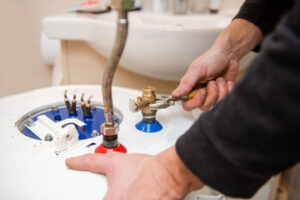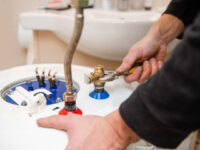How to Tell If Your Water Heater Needs Repair or Replacement
If your pilot flame lights but keeps going out, a faulty dip tube may be the culprit. Replacing it is relatively easy. 
Rumbling noises are caused by pressure fluctuations within the tank. A faulty temperature-pressure relief valve can cause serious tank damage if not repaired promptly by plumbers. For professional help, contact Water Heater Repair Spring TX now!
It’s a real pain when hot water comes out of your faucet and looks discolored. While it doesn’t necessarily mean your home has dangerous contaminants in it, this can still be a problem and needs to be addressed by a plumbing professional. Discolored water may be a sign of multiple issues, from simple mineral sediment to corroded pipes that need replacing. Depending on the cause of the discoloration, there are different steps you should take to resolve it.
If you notice that only your hot water is discolored, there’s a good chance it’s caused by sediment or minerals that have built up in your tank. If this is the case, you’ll want to drain and flush your water heater. This will remove any sediment that’s been accumulating, and it will also help your water heater run more efficiently and last longer.
Discolored hot water can also occur when iron-reducing bacteria get into a home’s water supply. These bacteria literally “eat” iron—not by taking bites out of it but by oxidizing it, which can leave the water brown or discolored. This can be a problem in homes that use wells instead of municipal water sources, as well as in small and medium commercial buildings that rely on a well for their water.
Lastly, if the discolored water is coming from your hot water tap and not the cold water, it could be caused by new copper plumbing that hasn’t been properly installed or by old, rusting copper plumbing. If this is the case, you’ll need to call your local water company to see if they’re conducting maintenance or repairs near your home.
If your home’s hot and cold water are both discolored, it’s likely because of a problem with the public water system. If this is the case, you’ll likely need to wait for the discoloration to clear before calling a plumber. If you’re in a hurry, you can run some faucets that haven’t been used for several hours to bring in fresh, clean water from the mains. This should clear the discoloration fairly quickly, and it will let you know whether the issue is caused by your home plumbing or the public water supply.
Smell
The smell of rotten eggs is one of the most well-known symptoms that your water heater needs to be repaired or replaced. It occurs when sulfur bacteria build up in your hot water tank. This is because sulfate-reducing bacteria (SRB) react with the magnesium anode rod in your water heater, causing hydrogen sulfide gas to build up in your system. You can prevent this from happening by replacing the anode rod with a zinc-zinc alloy rod, which will not react the same way with SRB and reduce the rotten egg odor in your water.
You may also notice a burning smell, especially if your water heater is old and worn out. This odor can be caused by dust and grime that has burned on the inside of your water heater. If this is the case, you will need to clean your water heater tank and drain pan. If you aren’t comfortable doing this yourself, contact a professional to do it for you.
A burning rubber or plastic smell is another sign that something is wrong with your water heater. This is typically caused by a problem with the burner on your gas water heater. This can be dangerous and should not be ignored. It can cause damage to your water heater as well as the gas lines in your home. It is important to call a plumber as soon as possible if you detect this smell.
If the rotten egg smell is present only when you run your hot water, it could be because of a contamination problem in your well water supply. SRB can be found in groundwater that comes from private wells and is commonly called a “foul taste” or “rotten egg odor.” In this scenario, you will need to test your well water to see if it contains SRB, as well as treat your well with a water treatment system.
The last and most severe odor is the smell of fuel or gas. This usually indicates a gas leak and requires immediate attention. Turn off your gas, open a few windows, and then call 911 or the local utility company to report the problem.
Lack of hot water
Water heaters use a lot of energy to produce hot water. Heating your water is the second-highest expense in most homes, so keeping yours well-maintained and efficient is key. If you’ve noticed that you don’t have enough hot water for showers, washing machines, and other appliances, it could be an indication of a problem with your heater or a clog in your pipes.
If you’re not getting enough hot water, try lowering the temperature on your thermostat. If this doesn’t help, it might be time to replace the thermostat. A new thermostat costs only $20, so this is not a costly repair.
Another potential problem is a dip tube leak. The dip tube is the pipe that transfers cool water from the top of your tank to the bottom so it can be reheated. Over time, the dip tube can wear out, causing cold water to mix in with your hot water. This is a relatively easy, cheap, and quick repair to make.
When you’re not getting enough hot water, it may also be a sign that your tank is undersized or that the thermostat and cutoff switch are faulty. Start by turning off the power to the unit and then resetting it. Next, you should check to see if the circuit breaker and the high-temperature cutoff switch have tripped. If they have, reset them by opening the access panel and pressing the red button (the high-temperature cutoff reset button) located above the upper thermostat.
Finally, you should check to see if the pressure relief valve has opened or is leaking. If it is, you should call a plumber immediately. Leaking pipes are not only a nuisance, but they can also lead to carbon monoxide and even natural gas leaking into your house. This can be a real health and safety concern for your family.
It’s always a good idea to get to know your plumbing system so that you can detect problems before they become major headaches. Check out our handy guide for troubleshooting your water heater, or contact a Roland J. Down Service Expert to learn more about saving on your utility bills with ENERGY STAR-rated units and other energy-efficiency upgrades.
Leaks
If you notice water leaking from your hot water tank, it’s important to identify where the leak is coming from and what caused it. This will help you determine whether your water heater needs repair or replacement.
There are a few different places where a water heater may leak. If the leak is originating from the bottom of the tank, it’s likely due to a faulty drain valve. You can check this by looking for moisture around the drain opening on your water heater. A faulty drain valve is relatively easy to fix and typically only requires tightening with a wrench.
Leaks from the top of the water heater are usually caused by loose T&P valves, anode rod corrosion, or cracking of the tank shell. Most of these problems can be fixed with simple repairs, and only a crack in the tank shell requires a full water heater replacement.
The first thing you should do when you notice a leaking water heater is turn off the power. This will prevent any further damage and reduce the risk of a dangerous situation. After the power is turned off, you can take a look at your water heater with a ladder or step stool. First, you should examine the cold water inlet and hot water outlet pipes. These pipes are what bring water into your home to be heated by the water heater and then out for use in your household. If these pipes are loose, you can tighten them with a pipe wrench.
You should also examine the plumbing connections above your water heater. Using a ladder, you should check both the rigid and flexible supply tubes that run into your water heater. You should look for any signs of water leaking from these connections or rusting on the tubes or fittings. If you notice any, it’s a good idea to replace them as soon as possible to avoid future problems.
The final place you should check for a water heater leak is the internal tank itself. The most common cause of an internal tank leak is failure to flush and remove sediment on a regular basis. This sediment builds up inside the steel tank and causes rusting and cracking, which can lead to a leak.






